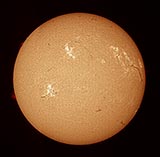Sun in H-Alpha - 2012 Aug 11 - 3
A hydrogen-alpha telescope reveals a prominence along the Sun's limb and a wealth of surface detail. The image is oriented with Celestial North up.
H-alpha is a narrow line at the red end of the visible spectrum. It is caused by a transition in the hydrogen atom when an electron drops from its third to second lowest energy level.
The Sun is composed primarily of hydrogen and its upper atmosphere or chromosphere glows in the red light of h-alpha. A telescope with a specially designed h-alpha filter can reveal amazing structures in the chromosphere that are not visible in white light. Enormous prominences rise above the Sun's surface reaching altitudes of 150,000 km or more. When seen silhouetted against the solar disk prominences are then called filaments. They often underlie coronal mass ejections and are important to the prediction of space weather. Spicules are long thin tubes of luminous gas that can change in a matter of minutes. Powerful magnetic explosions known as solar flares form in the most active regions and eject clouds of electrons, ions, and atoms through the Sun's corona into space.
Technical Details
- Object: Sun in H-Alpha - 2012 Aug 11 - 3
- Date/Time: 2012 Aug 11 at 18:53 UTC
- Location: Bifrost Astronomical Observatory, Portal, AZ
- Mount: Losmandy G-11 German Equatorial Mount
- Telescope: Coronado SolarMax Telescope (40mm aperture, double-stacked H-Alpha filter)
- Camera: Point Grey Research Chameleon (monochrome, 1.2 MP)
- Video Sequence: 15 fps for 60 seconds
- File Name: sunha12aug11-03w.jpg
- Data Acquisition: Acer (AS5750Z-4835), FireCapture Software
- Processing (Registax): stack 70% best images; wavelets
- Processing (Photoshop CS6): Layers, Masks, High Pass Filter, Curves, Color Balance
- Rights: Copyright 2012 by Fred Espenak. All Rights Reserved. See: Image Licensing.



